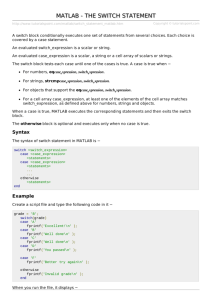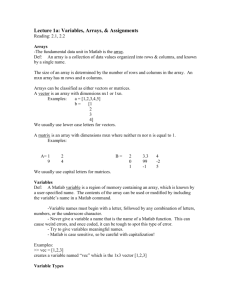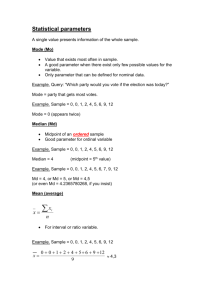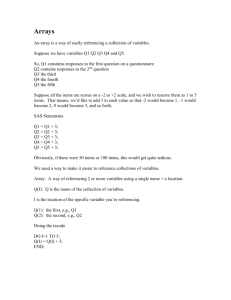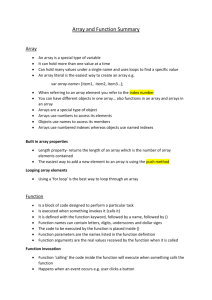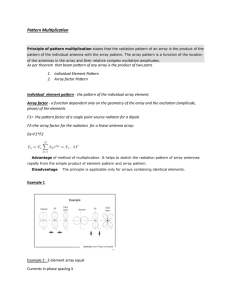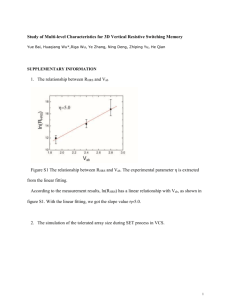Document 5632250
advertisement
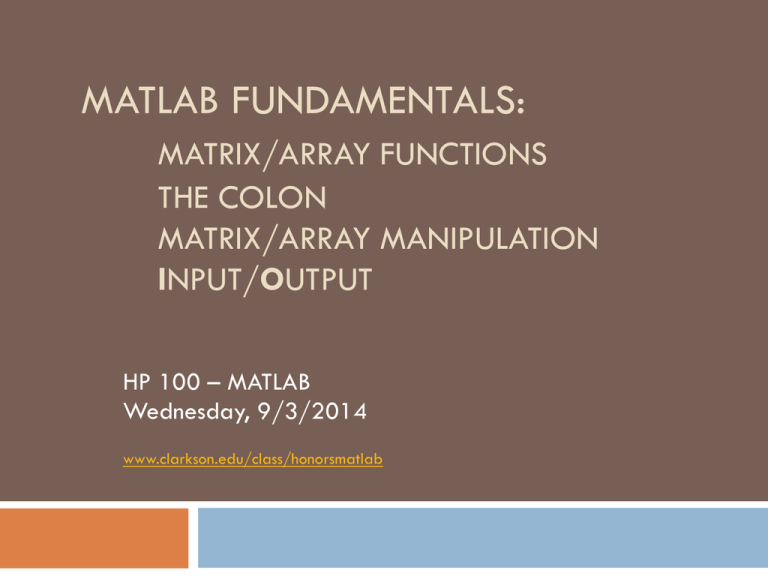
MATLAB FUNDAMENTALS:
MATRIX/ARRAY FUNCTIONS
THE COLON
MATRIX/ARRAY MANIPULATION
INPUT/OUTPUT
HP 100 – MATLAB
Wednesday, 9/3/2014
www.clarkson.edu/class/honorsmatlab
Before We Begin:
Any Questions? Comments? Concerns?
Feel
free to contact Joe or Jim
We
can set up small group tutoring or one-on-one
You can email us with any questions or concerns
We are here for you! Even if it isn't about MATLAB
Quote/Video of the Week
“English is ambiguous. If someone said, ‘The horse
flies like the devil,’ they could either be advising
me on a horse race, or merely commenting on the
rising tide of Satanism among some insects.”
- Professor Felland
Foundations of Mathematics
https://www.youtube.com/watch?v=I15bDqhkxwE
Matrix/Array Functions
A = [1 1 1; 1 1 1]
A =
1
1
1
1
1
1
B = [0 0; 0 0; 0 0]
B =
0
0
0
0
0
0
1
1
1
1
C = [1 1; 1 1]
C =
Matrix/Array Functions
A = ones(2,3)
A =
1
1
1
1
B = zeros(3,2)
B =
1
1
0
0
0
0
0
0
1
1
1
1
C = ones(2)
C =
Matrix/Array Functions
Built in Commands/Functions: See Tables 3.5,6,7
max
min
mean
median
sum
prod
: Maximum Value
: Minimum Value
: Mean Value
: Median Value
: Sum of Vector
: Product of Vector
Matrix/Array Functions
Sorting Functions
Table 3.8
sort
sortrows
Size Functions
Table 3.9
size
Dimensions of Array
Largest Dimension
length
Special Values / Misc.
The following have special meanings:
- The constant 3.141592 …
i,j
- Imaginary Number
Inf
- Infinty, or overflow
NaN
- Not a number, Undefined (0/0)
clock - [year month day hour minute seconds]
date
pi
The Colon Operator
Used for:
Creating
Vectors
Referencing arrays
Future applications [loops]
Creating Vectors
A = [2 4 6 8 10 12]
A =
2
4
6
8
10
12
6
8
10
12
B = [2:2:12]
B =
2
4
C = [4:6:30]
C =
4
10
16
22
28
The Colon Operator
Let:
A =
2
-4
A(2,3) =
A(1, :) =
A(:, 3) =
A(:, 1:2:4) =
9
13
-3
1
10
6
The Colon Operator
Built-in function –
end
A =
4
5
1
7
2
9
13
6
8
A(:,end)= [13; 6; 8]
A(end,end) = 8
diag(A) = [4; 2; 8]
Matrix/Array Manipulation
You can define new arrays or matrices in terms of
other arrays or matrices.
This
can be tricky, but always try to say it out loud and
visualize what is happening.
I/O – Input / Output
Definition:
Hardcoding:
Setting variables equal to particular
numbers in the code.
Example:
The
Calculate the square root of a number.
number = 100;
sqrt_of_number = sqrt(number);
code snippet always calculates the square root of 100,
unless you manually change the code.
What if we want to do it for the number the user chooses
(whomever is using your program/code)?
I/O – Input / Output
Methods:
Ask
the user for input through the command window.
Load data from files.
Function inputs (We will get to this in a few weeks.)
Input Command:
number = input('Please Specify a Number: ');
I/O – Input / Output
Loading data from files:
Many
different ways, depending on what type of file it
is. We do this in the future.
Use
the load command.
I/O – Input / Output
Calculations, Manipulation, Calculations…
We
Still need to display our Results
Methods:
Display
in the command window
Good
for quick solutions, small amount of data.
Commands:
disp
fprintf
Write
the results to a file.
Great
for processing and saving lots of information.
A bit harder to do, can be highly customized.
Commands:
fprintf
save
I/O – Input / Output
Command:
Example:
disp
Converts a
number to a
string.
x = 5;
disp(x);
disp(['The value of x is ' num2str(x) ‘. Cool Ehh?’]);
Tells MATLAB to combine everything
inside together into an array, in this
case, a character array
Things inside of single quotation marks are
strings, or just simply text (stored as plain text)
I/O – Input / Output
Command: fprintf
This
can be used to either print out to the command
window or write to a file.
This is saved for your own reading/learning.
It’s another way to display, also. It allows for more
formatting and pretty outputs
Example Code Time
The Golf Ball Example
Please
take note of lots of little things that are done,
they add to the readability and to the end results
being pretty
Problem Description:
Calculate
the X-Position and Y-Position of a golf ball hit with
an initial speed and angle. Assume constant acceleration
from gravity and no drag. Also find the maximum height
and display the results.
Homework
Please review/read:
Chapter
3, Chapter 4
It is very important to review the tables indicated and
go through the example problems.
Please do:
3.4,
4.1, 4.6
Before you go…
Do Problem 4.1 in the book


